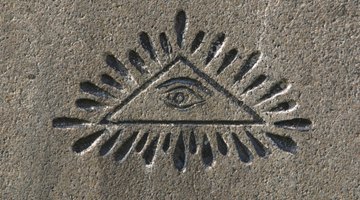How Long Does Stamped Concrete Need to Dry Before It Rains?
Concrete is a fickle surface that requires specific conditions to properly dry and harden without cracking or acquiring stains. The same goes for stamped concrete in which designs are stamped into the surface before it hardens. Until the concrete dries, you cannot walk, stand, drive or set objects on your stamped concrete surface. Additionally, rainy weather poses a problem for stamped concrete surfaces in the process of drying, or curing.

Concrete is a fickle surface that requires specific conditions to properly dry and harden without cracking or acquiring stains. The same goes for stamped concrete in which designs are stamped into the surface before it hardens. Until the concrete dries, you cannot walk, stand, drive or set objects on your stamped concrete surface. Additionally, rainy weather poses a problem for stamped concrete surfaces in the process of drying, or curing.
Curing Period
Prior to starting a re-surfacing project on your driveway, patio or walkway with stamped concrete, check the weather forecast. Concrete should be poured and stamped on a dry sunny day, with consecutive dry sunny days to follow. Generally, stamped concrete needs three to five days to dry, but as many as 90 days to fully cure. The surface should not be exposed to rain, even light rain, within the first 36 hours. After that, the surface is able to withstand some water.
Potential Problems
If an unexpected storm occurs and stamped concrete is exposed to rainfall within the first 36 hours of curing, you are likely to notice a white, powder-like substance on the surface as it dries. This substance is called efflorescence and is the consequence of the surface being exposed to rain before it has a chance to dry out. Fortunately, efflorescence is not permanent and can be removed by scrubbing with a 50/50 water and vinegar solution and a soft brush after the surface has dried. Wait three to five days before cleaning the concrete.
Protection and Precautions
As the weather is often unpredictable, have supplies on hand to protect the stamped concrete surface in the event of rainfall during the drying period. Generally, plastic sheeting is the go-to supply for covering a curing concrete surface. However, plastic sheeting also causes problems for drying concrete as pools of water collect on the surface and cause the material to come in contact with the surface. Plastic sheeting also prevents moisture from escaping the surface as it dries, causing it to be trapped.
The result is permanent blotches and discoloration of the stamped concrete surface. A light application of straw over the surface -- once it has dried enough to put straw on it -- before laying the plastic better protects the concrete from stains. Erecting a tent structure over the surface is an even better way to avoid discoloration and protect curing concrete in the event of a rainstorm.
Considerations
Rainfall can damage a drying stamped concrete surface, but other sources of water are also capable of damaging the surface. During the initial drying period it is important to protect stamped concrete from sprinklers and irrigation systems, as well as overflow or backwash from ponds, pools or other water sources like fountains or birdbaths. You may notice that the stamped concrete surface looks slightly blotchy or discolored as it dries. This is a normal part of the curing process, and as long as the surface is not exposed to rain, it should even out as the surface fully cures.
References
Photo Credits
- Jupiterimages/Photos.com/Getty Images
- Jupiterimages/Photos.com/Getty Images
More Articles



